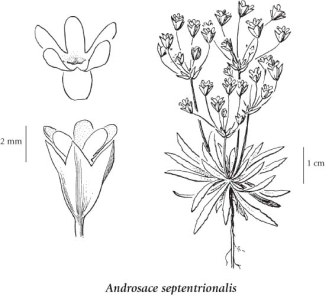northern fairy-candelabra (pygmyflower rockjasmine)
Primulaceae
Introduction to Vascular Plants
Map
Distribution of Androsace septentrionalis
Click here to view the full interactive map and legend
Species Information
General:
Plants annual or biennial, taprooted.
Leaves:
Leaves in a single basal rosette, oblanceolate to spatulate, 5-30 mm long and 3-10 mm wide, entire to sharply toothed towards the apex, margins often ciliate, surfaces glabrescent to hairy with straight hairs.
Flowers:
Inflorescences of 3-25 flowers; involucral bracts linear-lanceolate to narrowly lanceolate, not leaf-like, 3-6 mm. Flowers long-stalked; corollas tubular, white, slightly exceeding the calyces, 1-3 mm wide; calyces narrowly campanulate, prominently keeled, glabrescent to finely short-hairy, lobes triangular and shorter than the tube, 2.5-5 mm; pedicels erect to spreading, unequal, usually much longer than the calyces, 3-60 mm. Flowering Apr-Jun Jun (to Aug at high elevations).
Fruits:
Capsules globose or subglobose, about equalling the calex, 5-valvate.
Stems:
Scapes 1-5 (10) per plant, glabrescent to moderately hairy with branched hairs (sometimes glandular), 3-25 cm tall.
Notes:
A polymorphic species, both as to hairiness and stature, but not easily separated into natural infraspecific taxa.
Source: The Vascular Flora of British Columbia, draft 2014.
Author: Jamie Fenneman
Illustration

If more than one illustration is available for a species (e.g., separate illustrations were provided for two subspecies) then links to the separate images will be provided below. Note that individual subspecies or varietal illustrations are not always available.
Illustration Source: The Illustrated Flora of British Columbia
Ecology
The table below shows the species-specific information calculated from
original data (BEC database) provided by the BC Ministry of Forests and Range.
(Updated August, 2013)
| Site Information |
Value / Class |
||
|
Avg |
Min |
Max |
|
| Elevation
(metres) |
1289 | 275 | 2682 |
| Slope
Gradient (%) |
33 | 0 | 130 |
|
Aspect (degrees) |
186 | 10 | 360 |
| Soil
Moisture Regime (SMR) [0 - very xeric; 4 - mesic; 8 - hydric] |
2 | 0 | 5 |
| Modal
Nutrient Regime
Class |
C | ||
| #
of field plots species was recorded in: |
195 | ||
| Modal
BEC Zone Class |
BG | ||
|
All BEC Zones (# of stations/zone) species was recorded in |
AT(16), BAFA(5), BG(62), BWBS(11), ESSF(34), ICH(2), IDF(30), IMA(9), MS(1), PP(5), SWB(9) | ||
|
Source:
Klinkenberg 2013
|
|||
Habitat and Range
Moist to dry meadows, open slopes, grasslands, and disturbed areas in the steppe, montane, boreal, parkland, subalpine, and alpine zones. Frequent in BC in and east of the Coast-Cascade Mts., rare in sw BC (Vancouver I.); south to CA, AZ, NM, TX; Greenland; Eurasia.Source: The Vascular Flora of British Columbia, draft 2014.
Author: Jamie Fenneman
Status Information
Synonyms
Synonyms and Alternate Names:
Androsace septentrionalis var. septentrionalis L.
Androsace septentrionalis var. subumbellata A. Nelson
Taxonomic Keys
Key to Androsace
1a. Plants perennial, mat-forming, from a branched caudex; leaves grey soft-hairy, in multiple rosettes; flowers 4-8 mm wide, white with a yellow throat; pedicels shorter than the calyces……………………….....…………………..…….A. chamaejasme 1b. Plants annual or biennial, not mat-forming, from a taproot; leaves glabrescent to hairy with straight hairs but not grey soft-hairy, in a single basal rosette; flowers 1-3 mm wide, white; pedicels much longer than the calyces…………………………...2 2a. Involucral bracts broadly lanceolate to oblong or ovate, leaf-like; corollas essentially included within the calyces; calyces not keeled; calyx lobes narrowly ovate, about equal to the tube………………...……….………….………...……..A. occidentalis 2b. Involucral bracts linear to lanceolate, not leaf-like; corollas slightly exceeding the calyces; calyces keeled; calyx lobes more or less triangular, shorter than the tube…………….………...……………………………………………..…A. septentrionalis
Source: Vascular Flora of British Columbia, draft version February 2014 |
Taxonomic Notes
This is a highly polymorphic species, and several infraspecific taxa have been recognized in the past. Subspecies that have been attributed to B.C. include ssp. subulifera, ssp. subumbellata, and ssp. puberulenta (Robbins 1944); however, most or all of the variation is apparently attributable to environmentally-induced phenotypic plasticity rather than underlying genetic factors (Inouye et al. 2003) and, as a result, only a single variable taxon is recognized here. Plants are especially variable in size, stature, shape of the calyx lobes, pubescence, and presence of glands. This is one of few annual species that occurs naturally in the alpine zone, where the plants are usually dwarfed and stunted relative to lower elevation populations; some high elevation plants may persist for more than one year.
Source: The Vascular Flora of British Columbia, draft version February 2014 |